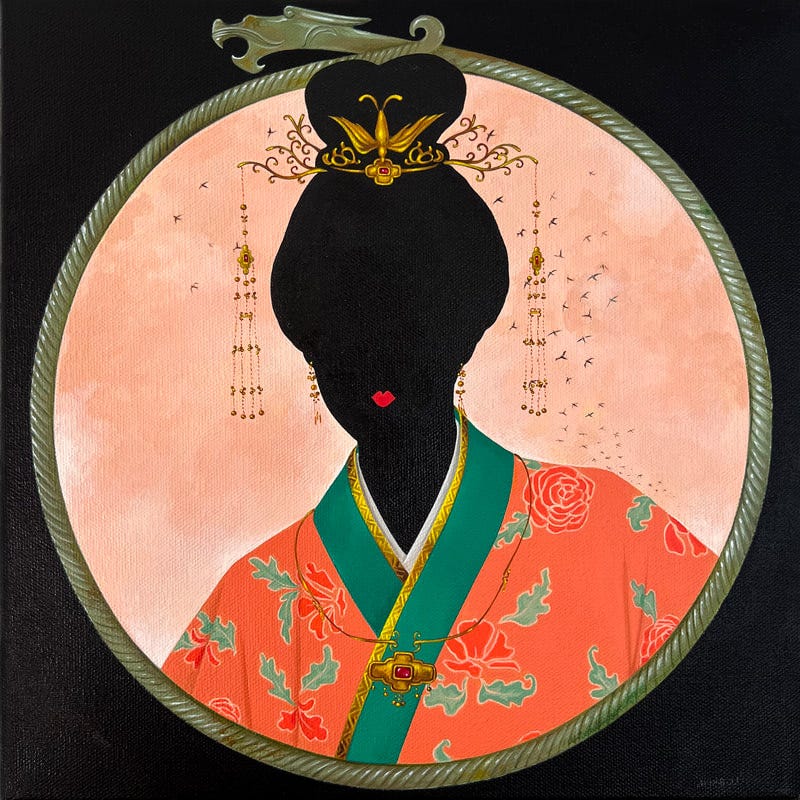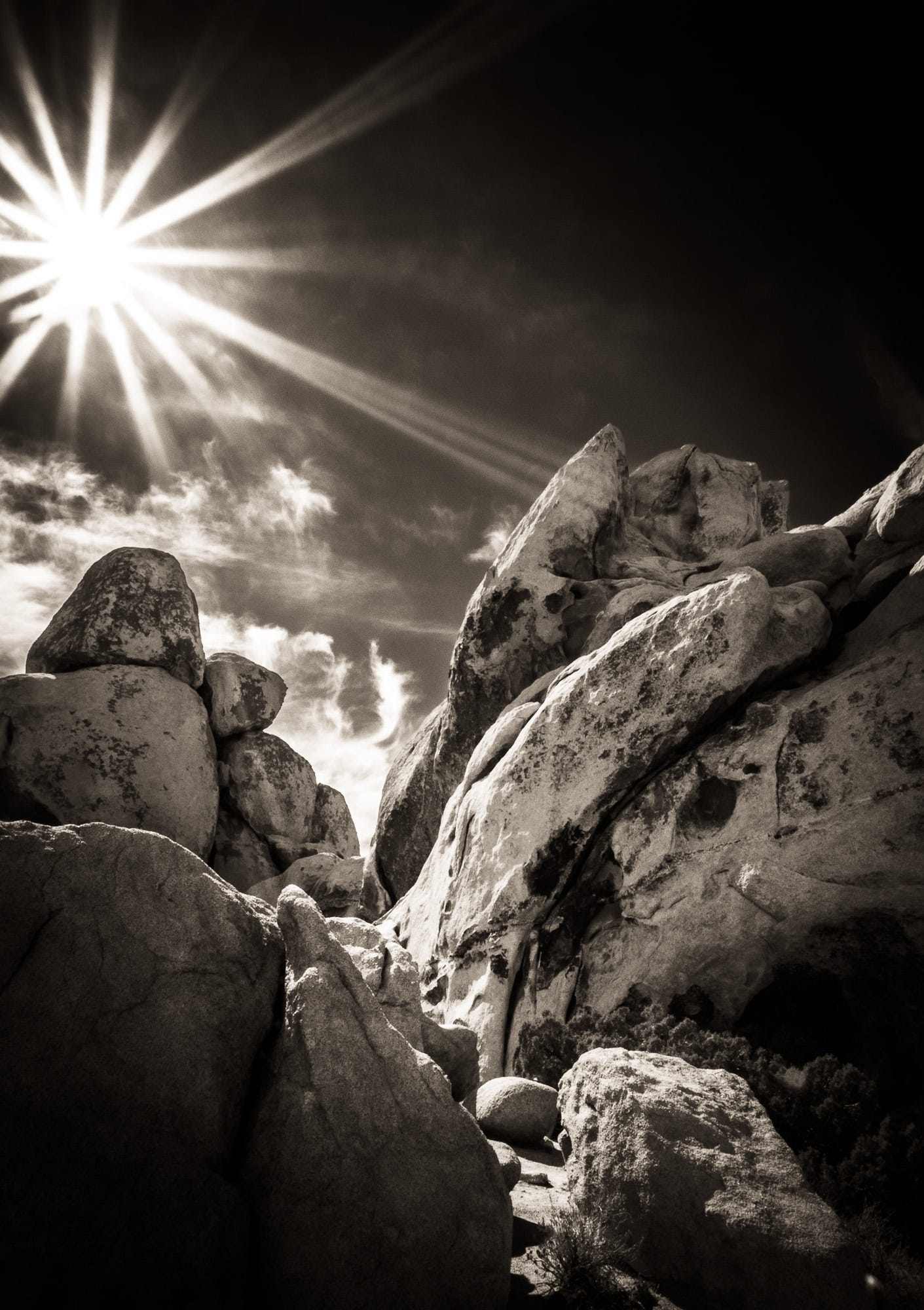Known but Unseen
Maremi Andreozzi's faceless women; Sheila Giolitti's interconnections; Hedieh Javanshir Ilchi's liquid landscapes; Tom Sliter's rock gardens; and Jeff Herrity's defectives
Maremi Andreozzi, “Zhao Feiyan” (Adah Rose Gallery)
AS SCRUPULOUSLY RESEARCHED AS THEY ARE PAINSTAKINGLY RENDERED, Maremi Andreozzi's paintings of historical women offer much information. What they don't do is fill in the features of people who lived long before the selfie era; the local artist portrays settings, clothing, and elaborate jewelry while keeping the faces merely as silhouetted black voids. Lives and periods are evoked while mysteries are maintained.
Andreozzi's contributions to "Any Season Will Be the Finest Hour," a two-woman show at Adah Rose Gallery, are split between two series. One represents colonial-period American women who weren't restricted to hearth and home; they include inventors, merchants, a lighthouse keeper, and an "ice cream innovator." The second set portrays courtesans who are sufficiently notable to be remembered by history, including one who rose to be an empress: Byzantium's Theodora, already enshrined as a feminist paragon in Judy Chicago's problematic "The Dinner Party." (Was Theodora, despite some acts of kindness, a vindicative tyrant? Almost certainly.)
The artist's style and attention to detail are neoclassical in outlook. Andreozzi takes pleasure in fabric folds and golden twists, and conveys that delight contagiously. The biographies of the featured courtesans, whose stories span from ancient Greece and India to Edo-period Japan, are intriguing. But these tales are nearly upstaged by such decorative touches as the ornate round or oval frames the painter invented to hold the images of her colonial women subjects. It's evident that for Andreozzi the past is as appealing visually as it is narratively.
The show's other participant is Sheila Giolitti, whose mixed-media painting-drawings array abstract and nature-inspired components. The Norfolk, Va. artist uses non-absorbent Yupo paper so that pigment pools and diffuses, adding to the watery feel of artworks that sometimes suggest coral reefs. Loose and tightly outlined forms nudge each other, and neatly rendered sprays of droplets, sometimes reversed, are a recurring motif. The effect is to convey what the artist's statement terms "interconnectedness of all matter and consciousness." The many elements in Giolitti's sprawling, layered compositions appear to be going every which way, and yet they're moving in harmony.
Hedieh Javanshir Ilchi, “Across the misty spaces of the intervening world” (VisArts/Hemphill Artworks)
THE VIVID PAINTINGS IN HEDIEH JAVANSHIR ILCHI'S VISARTS SHOW contain her customary ingredients, but in different proportions than usual. The Tehran-born local artist has long punctuated fluid abstraction with fragments of traditional Persian motifs and snippets of Euro-American-style landscapes. That last ingredient is more prominent than ever in "Tell me to weave my world from these dark filaments," a selection of 15 mostly vertical paintings that resulted from a 2024 residency at the Rockville art complex.
Like Katherine Tzu-Lan Mann, whose "Seed Float" mural just ended a run at the VisArts-programmed 355 Pod Space, Ilchi begins by pouring pigment. More colorful than Mann's inky gushes, Ilchi's swirlingly layered forms evoke clouds and oceans, but also the sort of harsh chemicals that pool with incongruous beauty. Atop the random flows, the painter adds trees and mountains and intricate filigree derived from Persian illuminated manuscripts. A few of these pictures also highlight tailed descending forms that might be shooting stars, but have bulbous heads that appear more biological than celestial.
The show places a series of smaller paintings, rendered liquidly on non-absorbent Mylar, alongside larger ones, including the gorgeous triptych "This time merciful nature saved us from ourselves." Least expected are the pictures that are dominated by landscape, notably one in which a succession of cone-like mountains, elegantly framed by spindly silhouetted trees, suggests East Asia's volcanic peaks. It underscores the potential of Ilchi's paintings, in the process of building from abstraction to representation, to lead just about anywhere.
Tom Sliter, “Sunlit Canyon” (Multiple Exposures Gallery)
THE HEAVY STONES IN THE FOREGROUND OF TOM SLITER'S photographs appear implacable and invulnerable. But the forces that have shaped them over millennia can be discerned in the backgrounds of the pictures in "Chiseled by Time: Sculpture of the Mojave Desert," the local artist's Multiple Exposures Gallery show. Hot sunlight, soft clouds, and dark skies represent the environment that has gradually eroded the rocky landscapes into their current forms.
Sliter's statement calls his subjects "nature's own Zen gardens," and stones do dominate the pictures in this series. The photographer conveys both the sheer bulk of the boulders and their intricate textures, which he accents by adding sepia toning to the black-and-white digital images. The gently grainy surfaces are set off by shadowy crevices and occasional scraps of spiky or prickly vegetation, blooming improbably from the rock.
Above are skies, presumably blue to the naked eye, that often verge on black. Whether this effect is achieved with filters or computer imaging, the ebony heavens dramatically frame the gray stones and white wisps of cloud. They also suggest the power of wind and rain that, over time, wear and gouge the chunky stone loaves and near-orbs.
All the pictures are medium shots that verge on closeups, save for one widescreen composition. Intriguingly, Sliter carefully tears the edges of his prints. The ragged borders echo the violence of erosion and tectonic shifts, but they also show the presence of the creator. In the digital age, Sliter demonstrates the power of still doing some things by hand.
Installation view of Jeff Herrity’s “Material Defects” (photo by Camille DeSanto)
A PORCELAIN BULL'S HEAD COATED WITH BATTERED SILVER LEAF impersonates an ancient artifact in "Material Defects." But most of the items in Jeff Herrity’s Transformer show evoke a much more recent historical era. The ceramic artist, a D.C. native now based in Richmond, employs the slip-casting technique his mother used when he was a child, as well as molds that are 30 to 50 years old. The resulting figurines, most of them rabbity, initially seem banal but reveal an eerie quality on closer inspection.
Herrity enlisted AI to inject flaws, calculated in intent yet haphazard in effect, into the designs. One rabbit has three ears, and two indeterminate creatures -- perhaps sheep -- have crashed into each other to become a single headless entity. The artist seeks "to highlight the unexpected beauty found in flaws," according to his statement, although some may find the mutations more unsettling than beautiful.
Most of the pieces are unglazed, their natural whiteness contrasted by their perches: translucent plastic shelves, often hot-colored. But one man-rabbit is bright orange, a few sculptures are embellished with metallic leaf, and a bear's head is covered in vivid green flocking. The color contrasts add another element to Herrity's mashup of classical technique and late-20th-century American kitsch. While the AI-generated flaws are random -- or appear to be -- the deployment of color is deliberate and savvy.
Maremi Andreozzi & Sheila Giolitti: Any Season Will Be the Finest Hour
Through March 8 at Adah Rose Gallery, 12115 Parklawn Dr., Rockville. adahrosegallery.com. 301-922-0162.
Hedieh Javanshir Ilchi: Tell me to weave my world from these dark filaments
Through March 9 at VisArts, 155 Gibbs St., Rockville. visartscenter.org. 301-315-8200.
Tom Sliter: Chiseled by Time: Sculpture of the Mojave Desert
Through March 9 at Multiple Exposures Gallery, Torpedo Factory, 105 N. Union St., Alexandria. multipleexposuresgallery.com. 703-683-2205.
Jeff Herrity: Material Defects
Through March 8 at Transformer, 1404 P St. NW. transformerdc.org. 202-483-1102.




